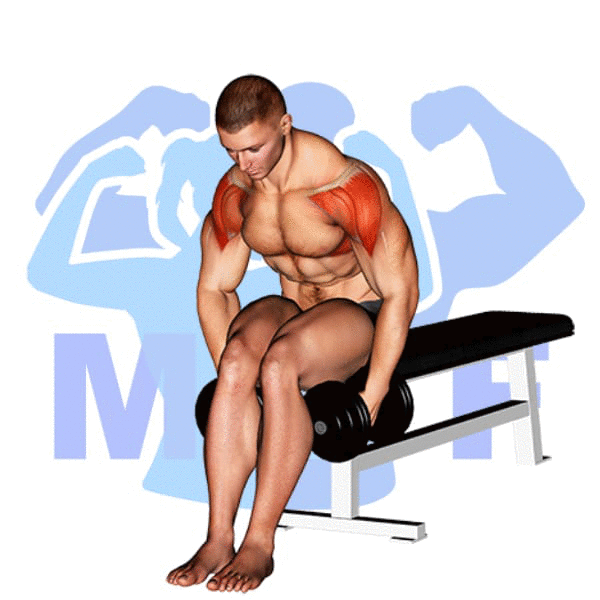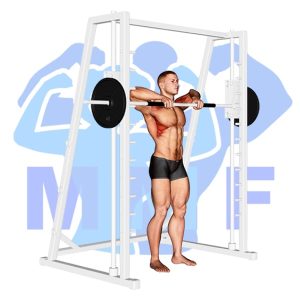Are you struggling to build your lateral deltoids but unsure how to properly perform the seated dumbbell lateral raise? Don’t worry, you’re not alone. Many beginner and even experienced lifters can struggle with performing this exercise correctly. The problem often stems from improper form, leading to an ineffective workout and potential injury. But fear not! With the right guidance and technique, you can master the seated dumbbell lateral raise and start seeing results in no time. In this blog post, we will explore the common mistakes made during this exercise and provide easy-to-follow tips on how to perfect your form for maximum results.
Seated Dumbbell Lateral Raise Summary
- Primary Muscles: Deltoid – Lateral
- Secondary Muscles: Deltoid – Anterior, Serratus Anterior, Supraspinatus, Trapezius – Lower, and Trapezius – Middle
- Equipment: Dumbbells and Bench
- Mechanics Type: Isolation
- Force: Push
- Utility: Auxiliary

Seated Dumbbell Lateral Raise Instructions
- Commence by taking up the dumbbells and having a seat on the end of a bench or chair with your legs in front of you.
- Bend forward slightly and start with the dumbbells under your thighs.
- Now with your elbows locked, the don’t need to be straight, just locked, raise the dumbbells out to the side.
- After you have your arms parallel with the deck you can pause then lower them back down again.
- Continue to do it again for your desired number of reps.
Video Tutorial
Seated Dumbbell Lateral Raise Muscles
Target (Agonist)
Synergists
Dynamic Stabilizers
- None
Stabilizers
- Levator Scapulae
- Trapezius – Upper
- Wrist Extensors
Antagonist Stabilizers
- None

Benefits of Seated Dumbbell Lateral Raise
The seated dumbbell lateral raise is an excellent exercise for building strength and size in the lateral deltoid muscle. This exercise targets the lateral deltoid muscle specifically, which is one of the three heads of the deltoid muscle. When performed correctly, this exercise can help to improve shoulder stability and strengthen the shoulder muscles. Additionally, it helps to improve posture and increases overall muscular endurance. By performing this exercise on a regular basis, you can expect to see an increase in the strength and size of your lateral deltoids.
Tips for Performing Seated Dumbbell Lateral Raise
For you to experience the greatest benefits, you will want to use these easily done tips. Most Importantly, when you need to avoid getting an injury, you would be wise to adhere to these tips.
- To Develop Power And Speed, Raise The Velocity Of Your Exercise. Preserve effective form or you might be more suboptimal to injuries. You will need to drop the weight to 50-60% of your single rep max weight when training for explosiveness. Also, you should now pause in between every repetition.
- Maintain Your Abs Tight. For most exercises, you will need to support your spine by flexing your abs to raise your inner pressure near your backbone.
- At All Times Incorporate Maximum Range Of Flexion. By using total range of motion you can ensure that you build the entire muscle and that you maintain your flexibility.
- Vary Your Training Sets Every Few Weeks With Varied Weight And Rep Combos. Such as set of 5 of 5 for a week or two, then 3 sets of 8-20 reps for a few weeks.
Benefits and Tips Video
Frequent Mistakes To Avoid
You will need to keep from making these typical issues to build and maintain good form and continue to develop gains. Likewise, when you eliminate these errors you will prevent the opportunity of having to deal with an injury.
- You Don’t Want To Ignore Any Of Your Pain. Tender muscles and injury pain are not necessarily always the same. Once you appear agony whenever you are training you should stop, or you can simply just mhelp to make this injury even worse.
- Try Not To Trai On Your Own. Your workout buddy is usually a good driving force. A training partner can certainly also be useful spotter.
- You Can’t use improper form. Inappropriate form is a rapid path to have an accident.
Find More Dumbbell Exercises Here
Variations and Complementary Exercises
Try spicing up your Seated Dumbbell Lateral Raise routine with these variations, complementary, or alternative exercises. By working similar muscles in different ways, you can break up the monotony of your workout and help build strength in a variety of ways. Here are some suggestions:
Seated Dumbbell Rear Lateral Raise

The Seated Dumbbell Rear Lateral Raise is a great complementary or alternative exercise for the Seated Dumbbell Lateral Raise. This exercise targets the posterior deltoids and works to strengthen the rear shoulder muscles. It can be performed while seated on a bench or standing with a slight forward lean. To perform the exercise, hold two dumbbells to your sides with your palms facing your body, then raise your arms up and out to the sides until they reach shoulder level. Make sure to keep your elbows slightly bent throughout the movement. This exercise can help to improve shoulder stability and strength while also helping to prevent injury.
Single Arm Lateral Cable Raises

The Single Arm Lateral Cable Raise is an excellent complementary or alternative exercise to the Seated Dumbbell Lateral Raise. This exercise involves standing and facing away from a cable machine, with one arm bent and raised out to the side. The cable should be set at a moderate weight and the arm should be kept straight as you slowly raise and lower it. This exercise is great for targeting the shoulders and upper back muscles, making it an effective way to improve posture, strength, and stability. It also helps improve balance and coordination.
Single Dumbbell Front Raise

The Single Dumbbell Front Raise is a great complementary or alternative exercise for the Seated Dumbbell Lateral Raise. This exercise helps to target the anterior deltoid and front shoulder muscles, and is performed by standing with your feet shoulder-width apart and holding a dumbbell in one hand in front of your body. Keeping your arm extended, raise the dumbbell up towards the ceiling until your arm is parallel with the floor, then lower the dumbbell back to the starting position. This exercise can be done with both arms at the same time, alternating arms or one arm at a time. It is important to keep your core tight and your back straight throughout this exercise to ensure proper form and safety.
Check Out These Top Dumbbell Exercises
Smith Machine Upright Row

The Smith Machine Upright Row is a great complementary or alternative exercise to the Seated Dumbbell Lateral Raise. It is an isolation exercise that targets the same muscle groups as the lateral raise, namely the anterior and medial deltoids, as well as the trapezius and rhomboids. The Smith Machine allows for a more controlled movement, allowing for maximum range of motion with less risk of injury. Furthermore, the upright row can be done with either a barbell or dumbbells, allowing for greater versatility.
Standing Cable Crossover Delt Fly

The Standing Cable Crossover Delt Fly is an excellent alternative or complementary exercise to the Seated Dumbbell Lateral Raise. This exercise works the same muscles as the Seated Dumbbell Lateral Raise, but in a different way. Instead of using dumbbells, the Standing Cable Crossover Delt Fly uses two cables that are attached to a high pulley system. You start by standing in the middle of the cables with your arms at a 45-degree angle to your sides. Then, you slowly bring the cables together in front of you, keeping your elbows slightly bent and your palms facing each other. As you do this, you should feel the muscles in your shoulders and back working. Once the cables meet in front of you, hold for a second before returning to your starting position. This exercise is great for building shoulder strength and stability.
Alternating Dumbbell Raise

The Alternating Dumbbell Raise is a great complementary exercise to the Seated Dumbbell Lateral Raise. This exercise helps to build strength and stability in the shoulder muscles, while also targeting the upper back and arms. Unlike the Seated Dumbbell Lateral Raise which focuses on isolating one arm at a time, the Alternating Dumbbell Raise requires both arms to work simultaneously. The alternating movement of the arms requires more balance and coordination than the Seated Dumbbell Lateral Raise, making it a great alternative exercise for those looking to increase their overall shoulder strength and stability.
Find More Shoulders Exercises Here
Opposing Complementary Exercises
To complete the exercise and ensure a balanced body, it is important to incorporate exercises that use the opposite muscle groups as the Seated Dumbbell Lateral Raise. Below are a few exercises that can be used to strengthen the opposing muscles:
Dumbbell Fly

Dumbbell Fly is an exercise that works the pectoral muscles, and is complementary to the Seated Dumbbell Lateral Raise which works the deltoids. Both exercises are important to developing a well-rounded upper body workout. The Dumbbell Fly provides balance to the routine by focusing on the opposing muscle group to the lateral raise, allowing for greater range of motion and fuller development of both the anterior and posterior deltoids. Furthermore, the Dumbbell Fly allows for a natural and full contraction of the pectoral muscles which can help promote increased strength and muscle definition.
Incline Dumbbell Fly

Incline Dumbbell Fly is an excellent complementary exercise to the Seated Dumbbell Lateral Raise as it works the opposite muscle group. This exercise is great for targeting the chest and shoulder muscles, as the arms move in a semi-circular arc while lying on an incline bench with a pair of dumbbells. This motion helps to open up and stretch the chest muscles, while at the same time increasing the strength and size of the pectoral muscles. This exercise is a great addition to any workout routine and helps to provide balance between the opposing muscle groups.
Incline Dumbbell Twisted Flyes

Incline Dumbbell Twisted Flyes are the perfect complement to Seated Dumbbell Lateral Raises. By targeting the opposing muscle group, this exercise helps to create a balanced physique. Incline Dumbbell Twisted Flyes work the chest, shoulders, and back muscles, specifically targeting the rear deltoids, rhomboids, and lower traps. This exercise also helps to improve shoulder stability and strength. To perform the exercise, sit on an incline bench with a pair of dumbbells in each hand. Lift the weights up and out to the side, keeping your elbows slightly bent and your palms facing inwards. Twist your wrists as you bring the weights up, before slowly returning them back to the starting position. The combination of Seated Dumbbell Lateral Raises and Incline Dumbbell Twisted Flyes will help you build overall strength and stability in your shoulders.
Get Stronger Shoulders with Seated Dumbbell Raises
Seated dumbbell raises are a great way to strengthen your shoulders and help prevent injuries. By performing this exercise, you are able to target the lateral deltoid muscles which will help improve the overall appearance of your shoulders. Additionally, stronger shoulders can help you perform daily tasks such as carrying groceries, lifting children, and playing sports with more ease. Incorporating seated dumbbell raises into your workout routine can help you achieve your fitness goals and live a healthier lifestyle.
References: Wikipedia | ExRx.net | PubMed.gov | Comprehensive List of Shoulders Dumbbell Exercises




